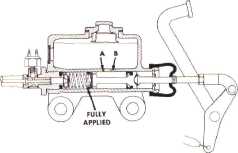|
1949 Delco Brakes Service Manual (Courtesy of Pat Gizz)
|
|||
|
DELCO
BRAKE
SERVICE
MANUAL
|
|||
|
|
|||
 |
sary because any
foreign matter in the system will
tend to clog lines, ruin the rubber cups, score cylinder walls, and
cause leaks which result in brake failure.
MASTER CYLINDER
DETAILED DESCRIPTION AND OPERATION
The Delco Hydraulic
Brake Master Cylinder con≠sists of a fluid reservoir cast integrally
and directly above the pressure chamber. A combination filler cap and
breather plug permits atmospheric pressure on the fluid at all times.
(See Figures 2 and 4.)
Depression of the
brake pedal causes the piston assembly and piston cups to move forward
in the Master Cylinder (See Figures 3B and 3C). Since there is only a
small clearance between the lip of the primary cup and the
compensating port "A," only a very slight forward movement of this cup
is necessary to close the port. Fluid is then forced through the check
valve into the "line." Actual braking pressure is not built up until
all the brake shoes come in contact with the drums. Henceforth,
additional pedal pressure results in increased brak≠ing action.
Release of the brake
pedal by the driver permits the pedal and push rod to return
independently of the piston to their "off" position. The piston spring
forces the piston to follow the push rod until the push rod makes
contact with the stop plate. The piston spring holds the primary cup
against the piston firmly while the brakes are released. An≠other
function of the spring is to exert pressure on the check valve
assembly, holding it in its seat.
At the time the brake
pedal is released, the re≠tractor
springs in the brake assemblies pull the shoes away from the
drums and hold them against the anchor pins. (See Figures 15 and 25.)
The con≠necting links (or
adjusting screws) at the same time force the pistons and cups
in the wheel cyl≠inders to their "off" position and the brake fluid
flows back through the lines, past the open check valve, into the
operating chamber of the Master Cylinder. Any excess enters the
reservoir through the compensating port. When the pressure in the
"line" equals the pressure exerted by the piston spring, the check
valve closes. Thus, a fluid pres≠sure of approximately 8 to 16 pounds
is always maintained in the wheel cylinders. This prevents air leakage
into the system. Air in the system causes
|
||
|
Fig. 3CóDelco
Hydraulic Broke Master Cylinder In Operation
Pressure applied to
the column of fluid, which is incompressible and which is
automatically kept at a correct volume, is transmitted by the
principle of hydraulics to all surfaces with equal and undimin-ished
force. The brake fluid enters into each of the four wheel cylinders
between their opposed piston cups, causing the pistons and connecting
links (or adjusting screws) to
move outward against the brake shoes, thus bringing the shoes
in contact with the brake drums.
(See Figures 1 and 3C.)
As pressure on the
pedal is increased, greater
hydraulic pressure is built up in the wheel cyl≠inders, and
consequently greater force is exerted against the brake shoes.
When pressure on the
foot pedal is released, the brake
shoe return-springs pull the brake shoes away from the drums
back to their normal or "off" position against the anchor pins. The
return of the brake shoes, in turn, causes movement of the wheel
cylinder pistons and cups toward each other, thus forcing the brake
fluid back through the line to the
master cylinder. (See Figure 3A.)
From the description
above, it will be noted that the fundamental operating principal of
Delco Hy≠draulic Brake Controls is the use of a master cyl≠inder
to originate pressure and the use of four wheel cylinders to
deliver the pressure to the brake shoes and linings that operate
against the brake drums.
CLEANLINESS IS
IMPORTANT!!
To maintain the
braking system properly, the me≠chanic must appreciate that a thorough
knowledge of the system, careful workmanship, and absolute cleanliness
is very important. Cleanliness is neces-
|
|||
|
|
|||